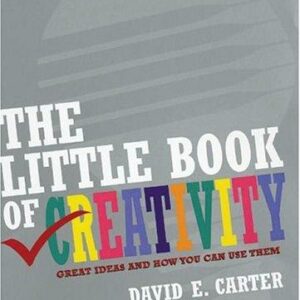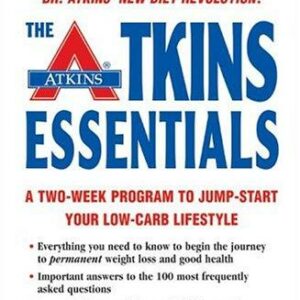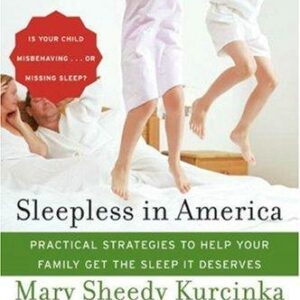The Happy Sleeper
$18.00
| Title | Range | Discount |
|---|---|---|
| Trade Discount | 5 + | 25% |
- Description
- Additional information
Description
Many parents feel pressured to “train” babies and young children to sleep, but kids don’t need to be trained to sleep, they’re built to sleep. Sleep issues arise when parents (with the best of intentions) over-help or “helicopter parent” at night—overshadowing their baby’s innate biological ability to sleep well. In The Happy Sleeper, child sleep experts Heather Turgeon and Julie Wright show parents how to be sensitive and nurturing, but also clear and structured so that babies and young children develop the self-soothing skills they need to:
• Fall asleep independently
• Sleep through the night
• Take healthy naps
• Grow into natural, optimal sleep patterns for day and night
The Happy Sleeper is a research-based guide to helping children do what comes naturally—sleep through the night.
The Happy Sleeper features a foreword by neuropsychiatrist and popular parenting expert Dr. Daniel Siegel, author of Parenting from the Inside Out and the New York Times bestseller Brainstorm.”Clear a space on your bookshelf! You’ll be consulting this friendly, research-based guide to the blessings of sleep for you and your little ones for many years to come.”
—Adele Faber, co-author of How To Talk So Kids Will Listen & Listen So Kids Will Talk
“Compassionate, courageous, and creative. . . Heather Turgeon and Julie Wright have written a user-friendly, scientifically-informed, practical guide that provides the information and intention you need to cultivate healthy sleeping habits not only for your child, but for yourself as well! Give your children the relationship security they need while also providing them the structure they require to sleep well and thrive.”
—from the foreword by Daniel J. Siegel, MD, New York Times-bestselling author of Brainstorm: The Power and Purpose of the Teenage Brain
“An important resource for parents seeking to give their children a lifetime of quality sleep. Good sleep habits are vital to child development and overall health, and The Happy Sleeper offers real-world strategies for getting children the sleep they need.”
—David M. Cloud, CEO, National Sleep Foundation
“Solid information on children’s brain development and physiology supports a clear and systematic “attunement” philosophy that strikes a happy balance between “cry it out” and “over-helping.” Turgeon and Wright’s compassionate but firm system reminds parents that even the smallest infants are already learners, and to be cognizant of what they want to teach.”
—Publishers WeeklyHeather Turgeon, MFT, is a psychotherapist who writes about child development and parenting. She is a science writer for the National Sleep Foundation, and her work has appeared in The New York Times and The Washington Post. She and Julie Wright have a sleep consultation practice and class series based in Los Angeles and available to families all over the world.
Julie Wright, MFT, is one of Los Angeles’s best known parenting group leaders and has taught thousands of moms in her popular Wright Mommy and Me program. Julie is a licensed psychotherapist working with infants, children, and adults, exploring attachment, mindfulness, parenting, and empathic communication. She and Heather conduct sleep consultations with parents in the LA area and remotely.
Foreword
Compassionate, courageous, and creative, The Happy Sleeper is a book for every parent of a young child to savor in its magnificent exploration of effective strategies for helping children get to bed smoothly and sleep well through the night. Heather Turgeon and Julie Wright have written a user-friendly, scientifically informed, practical guide that provides the information and intention you need to cultivate healthy sleeping habits not only for your child but for yourself as well!
Why is sleep so important? It is during sleep that we secrete the growth hormones our bodies need to grow and replenish themselves well. Sleep also allows our body and brain to rest and recover from the day’s activities. Recent studies have revealed, too, that during sleep our brains in effect clean themselves up—removing unhelpful by-products of the day’s neural activity—so that we can function well when we’re awake. Given all of this, it’s no surprise that babies and children need so many hours of sleep as they grow. Infants and toddlers sleep half their day or more! In childhood the amount of optimal sleep gradually decreases, but school-age children still need roughly 10 hours of sleep. Even as adults, we should spend about a third of our time sleeping!
Without the proper amount and quality of sleep, science reveals, we will have difficulty focusing, remembering, and calming our emotions. When we haven’t slept well we don’t learn or operate as effectively because our brain hasn’t had the necessary sleep time to optimize its functioning. Even more, without proper sleep, our immune system does not function well, and so we can become vulnerable to infectious diseases. And our metabolic system doesn’t function optimally, so we can be prone to overeat and not process food well, putting us at risk for obesity and diabetes. For each of these reasons, sleep is one of the most important “activities” we humans participate in. And as parents, helping our children develop good sleep hygiene is one of the most important contributions we can make to their well-being.
In this fabulous guide, you’ll learn to take important findings from sleep research and combine them with a crucial working knowledge of attachment research so that you’ll optimize not only your children’s sleep habits, but also their attachment to you. Attachment is all about providing security for your children through anticipating their inner needs, making them feel safe, and communicating with them in a soothing manner. Heather Turgeon and Julie Wright are brilliant sleep whisperers with decades of experience helping parents cultivate secure attachment while simultaneously shaping healthy sleep habits. That’s exactly the combination studies suggest is the win-win-win of effective parenting: give your children the relationship security they need while also providing them the structure they require to sleep well and thrive. And all this while you, too, get some important rest.
You’ll learn in these pages what science and clinical wisdom have to tell us about how to keep the relationship with your child filled with compassionate communication while also structuring healthy sleep strategies. You’ll discover how you can nurture emotional understanding between you and your child while at the same time implementing behavioral strategies that ensure they get the sleep they need. The authors provide you with a framework that will leave you feeling confident in the positive outcome of your approach. This is a plan that works.
Parenting is one of the most challenging roles one can play in life. It’s tricky to know when to hold our children close and when to let them venture out on their own to learn important skills, such as the self-soothing techniques that will help them be Happy Sleepers for the rest of their lives. Having this book as your companion, you will gain the clarity and conviction necessary to build a secure relationship with your child and, in turn, to help them build a secure relationship with themselves and their broader community. Read on, connect with compassion, creativity, and courage, and sleep well!
—DANIEL J. SIEGEL, MD
Introduction
Your baby already knows how to sleep.
Our clients are always shocked when they hear this. They’ve been breaking a sweat rocking their baby into a deep slumber, waking up every 2 hours to feed throughout the night, or wringing their hands in frustration with a wide-eyed, nap-resistant toddler.
But it’s true. Sleep is a basic action that babies are naturally born to do. Their bodies crave healthy sleep, and their brains are wired for it. By 5 or 6 months of age, almost all babies are capable of sleeping well without much assistance from Mom or Dad.
So why do so many families struggle at night? The answer is that most parents do what works today, don’t notice when it’s no longer needed tomorrow, and then keep pushing even harder when it’s become a hindrance the day after that. They work overtime with all kinds of fanfare and tricks to put their babies to bed. We’ve heard it all: parents feeding, rocking, and bouncing on a yoga ball for 45 minutes every night, lying down with kids, re-tucking, and refilling water glasses endlessly—one couple even told us they found themselves putting on a full music show with guitars, singing, and lights every night before bedtime.
Over time, parents’ “helping ways” overshadow their baby’s natural sleep abilities. Children get confused as to whether they or their parents are doing the soothing, and parents aren’t sure when and how much to back off so their little ones can take over the job.
The Happy Sleeper is the guide to doing just that. We will give you a clear, easy-to-follow system for transferring the role of independent sleep to your baby or child, as we’ve done for thousands of families in our practice. If you’re consistent in how you apply the methods in this book, your baby or child’s sleep will improve dramatically within one to two weeks.
Good Sleep Is in Their Genes
Kids don’t need to be trained to sleep; they’re built to sleep. Think about it: sleep is like other areas of development, and you know how quickly your baby learns. Within a year, a baby can sit, pull to stand, and maybe take her first steps. She understands language and soon she’ll speak in sentences. Almost overnight, she’s a master in all realms.
So why should sleep be any different?
For many babies, skills in other domains grow and improve, but sleep skills stall or regress.
But over and over in our practice, we see that it is. Children take off in their motor, social, cognitive, and language skills, while sleep skills stall and even decline as the months go on. It’s a common course for little kids—they show robust, thriving development in all other domains but actually regress in their ability to sleep.
In the early months, this happens when a soothing technique like nursing or rocking to sleep works and becomes your go-to habit (and we don’t blame you!). The problem is that while newborns often need these soothing devices, they outgrow this need quickly as their natural self-soothing abilities grow—sometimes within a matter of days or weeks. With toddlers and kids, the same idea applies. We know that they can sleep, but milestones and life transitions (learning to climb out of the crib, starting preschool, or having nightmares) rock the boat just enough to warrant a new trick (like lying down with them until they doze off) that kids quickly become reliant on.
As parents get stuck in a habit of soothing their little one to sleep, it masks the child’s natural abilities and makes it look as if she can’t sleep on her own.
Imagine your child was capable of walking, but you still carried her everywhere instead of letting her practice this new skill! This overhelping is the crux of family sleep problems. Eventually parents become exasperated, while baby’s sleep potential has actually been stifled.
Why We Wrote This Book
We wrote this book to help solve a dilemma. Over and over in our parenting groups, we’ve seen moms and dads work diligently to be responsive and nurturing around sleep, only to become frustrated, exhausted, and confused as their baby’s sleep gets worse instead of better. These parents feel stuck, and many reach the end of their rope and turn to a harsh, shut-the-door-and-don’t-go-in approach.
We know that sleep is a natural, hardwired function that shouldn’t be so difficult. As clinicians who follow science and new thinking on child development, we realized why sleep was stumping so many families—it’s the same overhelping or “helicopter parenting” dilemma that parents find themselves in elsewhere. Logic tells us (and research confirms) that overhelping doesn’t work: When we do things for our babies and kids that they are capable of doing for themselves, it keeps them from developing to their potential (in this case, their sleep potential). The problem is that, as parents, we don’t know how to stop overhelping, while still being warm and supportive to our kids.
The topic of baby sleep needs a fresh perspective. It’s been bogged down in old-school notions like “training” and misunderstandings of basic concepts like attachment. In this book, we take an integrated approach that is sensitive, simple, and truly effective. We don’t want anyone suffering sleep deprivation unnecessarily, nor do we ever want a baby to feel alone or fearful. Happily, neither of these ever needs to happen.
Our methods are based on two logical, research-based ideas. One: babies and little kids need warmth, sensitivity, and a sense that the world is a safe place. Two: they thrive best (and sleep best) when they have structure, routine, and clear expectations. When we work with parents to fix a sleep issue, we always locate the solution in one of these two places. If one of these is missing, a child’s sleep ends up falling short of what she’s developmentally capable of: a 10-month-old baby waking every 1 to 2 hours at night (you’d be surprised how many we’ve met!), an 18-month-old who only naps in a stroller, or a child refusing to fall asleep unless Mom or Dad snuggles up too.
These parents swear that their child’s not capable or is just a bad sleeper. But when we craft a sleep plan together (as we’ll do in this book), within a week or two their baby is sleeping eleven hours straight, their toddler is taking a beautiful 2-hour nap in her crib, or their child is kissing them good night, grabbing his stuffed animal, rolling over, and falling asleep on his own.
Sleep affects virtually every part of your child’s life. Well-rested babies and kids are emotionally balanced, flexible, and creative; they’re healthier; they think clearly and retain information better. When your child sleeps well, she (and you) feel the ripples of this everywhere. It’s amazing to see how good sleep transforms a family.
How to Use This Book
Chapter 1 is an introduction to childhood sleep issues, including information about how much sleep your baby or child needs.
Chapter 2 outlines the Happy Sleeper approach to good sleep for all ages (babies, toddlers, preschoolers, and young school-age kids). This chapter explains the underlying ideas that all of our methods are based on.
Chapters 3 to 5 have all the practical information, steps, and methods you need for your child’s particular age, and for any issue or goal you have with sleep.
Chapter 3 is for babies 0 to 4 months old.
Chapter 4 is for babies 5 to 24 months old.
Chapter 5 is for children 2 to 6 years old.
Chapters 3 to 5 are organized this way:
1. HEALTHY SLEEP HABITS
This is the foundation for good sleep. If you put these habits in place, your child will have the best chance of sleeping well, both now and in the long run. Even if you’re looking for the answer to a specific problem, don’t skip over this section—these habits strongly influence the quality of your child’s sleep.
2. SLEEP SOLUTIONS
For every sleep issue in your child’s age range, we have a solution that is responsive and supportive and keeps your baby or child in charge of soothing and independent sleep (with the exception of little babies ages 0 to 4 months, who are gradually growing into this capacity).
3. TROUBLESHOOTING
What to do about teething, motor milestones, potty training, sleep regressions, and more? The last section of each chapter answers common questions that arise for your child’s age.
Chapter 6 addresses special situations like bed sharing, traveling, and other arrangements and circumstances that can change the way your child sleeps.
Chapter 7 will help you, the parent, sleep well. We see too many parents sacrificing their own sleep needs. We want to help you make sleep a priority for you, not just your child.
Chapter 8 explains the science of sleep and how sleep develops over the first years of life.
The Appendix has tools for creating your child’s schedule, tracking progress on your sleep plan, and more. You’ll find more helpful tools on our website, www.thehappysleeper.com.
1.
Do any of these scenarios sound familiar?
You feed or rock your baby until she’s fast asleep, lower her gently into her crib, and tiptoe out of the room. Two hours later, she’s awake and calling for you.
It’s past bedtime, but your toddler runs when you try to put pj’s on him, breaks down in tears over brushing teeth, and summons you back into the room repeatedly for more water, another song, and different stuffed animal configurations.
You have to lie down with your little one until he falls asleep, which can take up to 45 minutes and, sometimes, you doze off, too.
Your baby will only nap in the stroller, car, or with you carrying her.
Your child stays up too late and you suspect he’s not getting enough sleep, but you can’t figure out how to get him into bed earlier.
Your child calls out to you at night and needs you to sleep with her, or to join you in your bed.
You and your partner are so exhausted you can barely function, much less be present or happy with your baby during waking hours.
• •
Sleep is a basic building block of your family’s health and happiness—just like good food and regular exercise. Sleep is about as natural as it comes; in fact, kids are literally built to do it. Their brains are programmed to develop good sleep from the time they’re babies.
Your child wants to sleep; and with the right patterns in place, her natural abilities will surprise you. Naptime, bedtime, and sleeping through the night—they don’t have to be a big struggle or a source of anxiety. As easy as it is to disrupt sleep and create unhealthy sleep habits, it’s achievable and often quick to get back on the right track. Consider this scene:
You help your baby wind down after her last feeding. You give her a bath and put on her pjs. After a few stories, a few cuddles, and a song, you kiss her good night, lower her into her crib, and leave the room. Your happy sleeper rolls over, grabs her lovey, moves into a comfortable sleep position, and drifts off until the next morning. You have time to yourself to eat dinner, read a book, or spend time with your partner before going to bed and getting a full night’s sleep.
If your baby is at least 5 months and you follow our approach consistently, you can go from one of the cumbersome patterns mentioned above, to this happy sleeper scene in roughly one to two weeks (if your baby is under 5 months, we’ll show you how to move in this direction). And if you read and adopt our fundamental concepts, your family will have a solid sleep foundation for years to come. It’s a myth that sleep is always a struggle and that changing sleep patterns is very hard. If you have a clear plan, your family’s sleep can improve quickly.
Good sleep not only makes life more peaceful and enjoyable, it’s a basic need that affects your child’s happiness, success, and health. Insufficient sleep is like having a big piece of your life’s foundation missing; it’s like walking around while your body starves for food or water.
Sleep is part of your foundation. When it’s off, the rest starts to crumble!
DID YOU KNOW . . .
• Napping helps babies learn and remember language.
• Missing sleep compromises the brain’s prefrontal cortex, which our kids need for decision-making, attention, and emotional control.
• Little kids who sleep fewer than 10 hours a night are twice as likely to have low scores on cognitive tests when they enter school.
• Too little sleep in childhood increases the risk of obesity.
Sleepy Nation: You Are Not Alone
Little kids are losing critical hours of sleep. It’s estimated that babies and young children get an average of 9½ hours of sleep per night, although experts agree that they need 11 to 12, and roughly one-third of kids have clinical sleep problems. A poll from the National Sleep Foundation found that half of infants and a third of toddlers get less sleep than their parents think they need. Seventy-five percent of parents with infants and 82 percent of parents with preschoolers say they would change something about their child’s sleep.
Caffeinated drinks are consumed by lots of sleepy adults and, if you can believe it, kids! The American Academy of Pediatrics notes that children ages 6 to 10 drink caffeinated beverages eight out of ten days. One study found that two-thirds of children ages 2 to 5 consumed drinks like soda and tea.
Why don’t kids sleep enough? There are lots of answers to this question, but here are two of the most common:
• We get confusing messages about sleep: cry-it-out, tough love, feed-on-demand, co-sleep . . . parenting approaches seem to contradict one another and leave many families puzzled and sleepless.
• We’re busy: life is bursting at the seams! Especially for families with older children, homework, technology, activities, and work schedules make it hard to protect aspects of healthy sleep like early, consistent bedtimes. Artificial lights and electronics delay sleep for children and adults, keeping us all up past our optimal bedtimes. Even though sleep should come naturally, our modern lives easily disrupt it.
Kids don’t necessarily grow out of sleep issues either; in fact, research suggests that a significant percentage of young children with sleep disruptions still have them years later. On the other hand, when you develop healthy sleep habits early, they grow with your child. Imagine that your baby, who is a self-soother, turns into a happy preschooler who feels confident and knows what to do when the lights go out, a school-age child who can have a sleepover at a friend’s house, and eventually a well-rested and sharp teen who’s set up for success. It’s not an overstatement to say that the positive sleep foundation you establish for your young child will be the one he has throughout his life.
HOW MUCH SLEEP DO YOU REALLY NEED?
Source: National Sleep Foundation
Take a look at sleep recommendations for every member of your family, including yourself. Just as with adults, children vary in how much sleep they need to function at their best, which is why there’s a range instead of a magic number. But almost all children consistently need this amount of sleep in a 24-hour period. It’s a lot of sleep—roughly half your child’s life or more! A very small percentage of people are thought to be “short sleepers,” or those who require less sleep than the rest of us. If your child seems fine with less than the recommended amount of sleep, you might be surprised that she does even better with 30 to 60 minutes more. Think about the fact that your goal is not just a child who is functioning, but one who is optimally alert, creative, and balanced.
How to Tell If Your Child Is Getting Enough Sleep
It can be tricky to tell whether your child is well rested, because kids rarely communicate this clearly. Insufficient sleep in children is hard to spot for two reasons:
• Babies and little kids don’t wind down when they’re tired—they wind up. Anyone who’s watched overtired kids run circles around a bouncy house, or throw a tantrum insisting on more television before bed will tell you this is true. Babies get overstimulated and fussy when they’re tired (as you’ll see in Chapter 3, that’s a big reason for the early evening “witching hour”). Sleep loss in older children is linked with symptoms of attention-deficit/hyperactivity disorder (ADHD).
• Kids aren’t good judges of their own sleepiness. In one well-known set of children’s sleep studies at Stanford, when kids’ sleep was restricted to just 4 hours a night, they still didn’t say they were sleepy. You really can’t count on your child to tell you when he’s tired—he needs you to help him wind down and sleep.
Overt sleepiness is especially hard to detect when little ones are on the move; sometimes it’s only obvious when they finally sit still—for example, riding in a car or sitting on the couch reading a book. This is when you’ll see signals of drowsiness, like your child rubbing his eyes or staring into space.
Here’s how you can tell whether you have a well-rested or sleepy child on your hands. Check the ones that apply to your child.
SIGNS OF A SLEEP-DEPRIVED CHILD
Needs to be woken up in the morning
Hyperactive, inattentive, moody, impulsive, or aggressive
Falls asleep before scheduled naps if taken on a walk or car ride
Sleeps in on the weekends
Falls asleep in school
Becomes clumsy, irritable, easily frustrated
SIGNS OF A WELL-RESTED CHILD
Wakes up naturally
Alert most of the day or until naptime
Doesn’t fall asleep in the stroller or car during the day (in between naptimes)
Has more or less the same sleep schedule on weekdays and weekends
Has the same nap habits at home and day care or preschool
What if your child does get enough sleep overall, but it happens in a way that isn’t working for the family—for example, your baby needs to be rocked and bounced for 30 minutes, or your toddler’s bedtime is a dragged-out affair of requests for extra water, bonus potty trips, and “just one more story.” Maybe your baby will fall asleep only with you in the bed, or will only nap in the stroller. In this case, your child might get enough hours of sleep total, but the manner in which he does it is disruptive or challenging, and it involves you overhelping, so he isn’t accessing his self-soothing abilities. These are important issues to address; good sleep isn’t just about hitting the numbers, it’s about setting up habits and routines in your house that feel good for everyone.
Throughout this book we’ll not only help you achieve long and consistent sleep for your baby or child, we’ll also walk you through how to make healthy sleep easy and pleasant (yes, you heard that right) for the whole family.
Good Sleep = Successful, Happy, Healthy
Watch your child sleep—eyes fluttering, arms limp, legs tucked up. It’s a beautiful and peaceful thing. We tend to think of falling asleep as shutting down (and feel incredible relief as parents when our kids finally do) but, actually, sleep is not your child’s “off mode.” Transitioning to sleep turns on a whole host of vital activities in your child’s brain and body. For example, when your child enters deep sleep, growth hormones are secreted that allow cells to divide and tissues to repair and regenerate. During sleep, memories are consolidated and your child processes information learned during the day.
Sleep is like nutrition for your child’s brain.
Even if you think you know the value of good sleep, you’ll probably be surprised to find out just how much sleep affects different areas of your child’s mental and physical health.
Learning and Academic Success
It’s a simple fact at any age—newborn, preschool, or teenager—good sleep makes for a higher-achieving child.
In one well-known experiment, researchers restricted or extended the sleep of school-age kids by 30 minutes and found that it had a significant impact on their reaction time, attention, and memory. In fact, the difference of 1 hour between the two groups made an impact that was equivalent to two years of academic level.
One of the best predictors of a child’s success in school is her level of “executive function,” or the ability to manage emotions, behaviors, and thinking—and this skill set is very sensitive to sleep loss. Many studies have shown that even after a modest decrease in sleep, the brain’s prefrontal cortex (the hub of executive function) becomes less active. Sleepy kids can still do the basics—talk, eat, run around, play—but sophisticated thinking, impulse control, and creativity go steadily downhill.
When your child sleeps, certain connections between brain cells are strengthened while others are “pruned” or lost (this is an important part of development because the brain is refining its circuits and prioritizing what it needs the most). This essentially remodels the brain and consolidates the information learned while awake. Babies have an intense need for sleep, which is probably because they have so much to learn. Infants learn language better after a nap, and preschool children’s spatial learning is boosted by a midday nap. From the ages of 2½ to 6 years, short sleep (fewer than 10 hours per night) has been linked to lower vocabulary and nonverbal intellectual skills, and this is true even of kids who later catch up to their peers in sleep duration. In other words, missing sleep early in life may have a lasting effect.
Behavior and Emotions
As an adult, how do you feel and act when you’re tired? You probably think and move slowly. You want to curl up, power down, and recharge. Your bed calls to you.
Sleepy kids don’t respond this way to being tired, or necessarily even know that they’re tired. Instead, they become stressed, wind up, and get a second wind.
Psychologists continue to find connections between sleep and ADHD. Children with sleep issues have a higher prevalence of hyperactivity and attention problems (and vice versa, kids with ADHD-like symptoms are at higher risk for sleep problems). Kids with ADHD also tend to be sleepier during the day, which might explain why stimulant medications seem to help. In fact, studies also suggest that treating sleep problems may be enough to eliminate hyperactivity and attention issues for some children. This benefit applies to kids without any diagnosed attention or behavior problems, too. One experiment showed that adding just 30 minutes more sleep per night made a significant improvement (for kids without any history of behavioral issues) in how restless, impulsive, and moody children were. Reducing sleep by 50 minutes had the opposite effect.
Health
Too little sleep is linked to weight gain in both kids and adults, and children who have short sleep durations are at higher risk for obesity when they grow up. Sleep loss disrupts chemicals in the body that regulate appetite and metabolism. Insufficient sleep also raises the risk of hypertension and can affect the immune system, which may make kids more likely to get sick.
Parents’ Life
Parents lose about 350 hours of nighttime sleep in the first year of their baby’s life. In a National Sleep Foundation poll, almost two-thirds of parents (even those with toddlers and preschoolers) reported getting less sleep than they need.
To some extent, this is just how it goes—a baby naturally turns your sleep schedule upside-down for a few months. Thankfully, parents can adapt; we seem to be biologically capable of flexing around a newborn’s every-2-hour waking pattern, being alert enough to tend to our babies at night, and still managing to go about our daily lives.
HERE’S HOW PARENTS DESCRIBE SLEEP DEPRIVATION
“I feel underwater and blurry, panicked and overwhelmed.”
“On edge. Easily angered. Forgetful.”
“In a fog and emotional.”
“Grumpy and hungry.”
“Disoriented and ‘off.’ Everything is harder on those days, especially remembering to smile.”
“Cranky, depleted, foggy, impatient, and unavailable!”
“Dread and nervousness as evening sets in.”
“Like a piece is missing.”
The problem is that for some parents, the initial sleep loss in the first few months becomes the new normal in the months and years that follow. These parents end up carrying a significant “sleep debt” because they accumulate missed hours of sleep over time without ever getting the chance to fully pay it back. People with children of all ages are roughly twice as likely as those without kids to say that they’re not sleeping enough and that they’re unable to do activities like exercise because they’re too sleepy. Subpar sleep also makes parents irritable, impatient, and less productive. It can make small tasks seem insurmountable and, even worse, keep us from enjoying and connecting with our kids.
10-MONTH-OLD EVAN AND HIS EXHAUSTED PARENTS
Joanna: When Evan was 10 months old, his sleep regressed dramatically and I found myself nursing him to sleep each night (even though we had cut this out of our routine 5 months prior). This put him to sleep for an initial 5-hour stretch, but after that, he was waking up hourly! My husband and I felt like we were in a dark cloud of exhaustion. The hardest part was that we started to feel resentment toward him and were enjoying him less. Once we carried out our sleep plan, the whole family started sleeping well and we went back to enjoying and finding so much pleasure in each other’s company.
Think about it this way: working on your child’s sleep is important for you and, in turn, your healthy sleep is important to your child, so you can feel available, patient, and energetic.
If that’s not enough, consider that poor sleep also poses a serious safety risk to your family. People with children in the house are significantly more likely to drive drowsy than those without kids. Drowsy driving is a major safety hazard: incredibly, 37 percent of adults say they’ve fallen asleep at the wheel (and 13 percent of those say they do so approximately once each month). It’s conservatively estimated that 100,000 police-reported crashes every year are a direct result of driver fatigue—resulting in 1,550 deaths and 71,000 injuries.
The Happy Sleeper
HERE’S WHAT MAKES A GOOD SLEEPER
• A warm, attuned parent
• A pattern of self-soothing
• Clear family sleep habits
• A regular schedule that supports natural, biological sleep mechanisms
Whether you’re coming to us in a blurry, sleep-deprived crisis, or you’re simply trying to optimize your baby’s sleep, with this book you’ll have all of these in place. Using our techniques, you’ll be able to fix immediate sleep issues and set up habits that support optimal sleep as your child grows.
If you’re conflicted about imposing a structured and harsh program to improve your child’s sleep, you can stop worrying. Warm, supportive parenting and a full night of independent sleep are not mutually exclusive—we’re going to show you how they work together naturally and seamlessly.
So now that we know the urgency of good sleep and elements you need to get it, let’s look at the Happy Sleeper approach to getting there!
2.
“Cry It Out” Versus “Attachment Parenting” Sleep Methods
If you’ve reached out for sleep help before, you know that it can sound polarized into methods of “crying it out” and “attachment parenting.” The first emphasizes structure and independent sleep; the second tells you to be flexible and responsive to your baby’s needs. These approaches seem to contradict each other.
But this is a false, unhelpful divide. It makes parents unduly upset and confused because independent sleep and a loving, secure attachment are pitted against each other—as if they are at odds. In psychological terms, “attachment” involves being there to support your little one, while also encouraging her to learn, develop, and move toward independence (you can read more about attachment here). When you change a pattern to improve your baby or child’s sleep, there is usually protesting involved—you’re doing things differently and reshaping a well-entrenched habit! This is okay. If you are careful, thoughtful, and consistent in how you do this, your baby will feel supported (even though she may express big feelings about the change), and eventually she’ll learn a new pattern that helps her sleep well. Passing the job of soothing to your capable baby or child is very much in line with attachment theory.
For the best sleep, you need both the consistency of structured sleep training programs and the responsiveness (or as we will call it here, the “attunement”) of attachment-friendly ideas.
The Happy Sleeper Approach
Consistency and Attunement for Good Sleep
In this section we’ll look at two important aspects of healthy sleep—consistency and attunement—and how they work together to produce great little sleepers.
Consistency: Your Tiny Scientist
You know that consistency is important in all realms of parenting, but do you know it’s because your child’s brain, even as a newborn, is set up to detect and understand patterns? Newborns acquire knowledge and skills at a breathtaking pace and they are capable of associative learning (linking and remembering objects and events in their environment) right from the start.
THE PATTERN-SEEKING BRAIN
US
Additional information
| Weight | 11.6 oz |
|---|---|
| Dimensions | 0.9500 × 5.5100 × 8.2400 in |
| Imprint | |
| ISBN-13 | |
| Author | |
| Audience | |
| BISAC | |
| Subjects | gifts for new dad, back to school books, nanny gifts, gifts for new dads, baby sleep book, sleep training, gifts for new parents, mindful parenting, gift for new dad, parenting book, sleep training for babies, baby sleep, the good sleeper, sleep system, sleep better, new dad gift, happy baby, no cry, baby books, self help, mindfulness, FAM039000, FAM025000, parenting books, new dad gifts, gifts for dads, happy, parenting, Babies, self help books, self care, self-care, gifts for moms, baby shower gifts, Child Development, self help books for women |
| Format |











